TABLE A.1 Summary of External Trade Performance
February 2020 and February 2019
| Exports | Imports | |||
| February 2020p |
February 2019r |
February 2020p |
February 2019r |
|
| TOTAL | ||||
| FOB Value (in Million USD) | 5,400.68 | 5,251.62 | 7,056.87 | 7,984.95 |
| Year-on-Year Growth (Percent) | 2.8 | 0.5 | -11.6 | 2.9 |
| Electronic Products | ||||
| FOB Value (in Million USD) | 2,928.98 | 2,832.37 | 1,996.98 | 2,046.90 |
| Year-on-Year Growth (Percent) | 3.4 | 1.3 | -2.4 | -3.8 |
| p – preliminary, r – revised | ||||
A. TOTAL EXTERNAL TRADE AND BALANCE OF TRADE
1. Total external trade decreases by 5.9 percent
The country’s total external trade in goods in February 2020 amounted to USD12.46 billion, a decline of 5.9 percent from the USD13.24 billion external trade in the same month of the previous year. Of the total external trade, USD5.40 billion (43.4%) were exported goods and USD7.06 billion (56.6%) were imported goods. (Figure 1)
The country’s balance of trade in goods (BoT-G) in February 2020 posted a USD1.66 billion deficit, which was lower by 39.4 percent than the USD2.73 billion deficit in February 2019. (Figure 1 and Table 1)
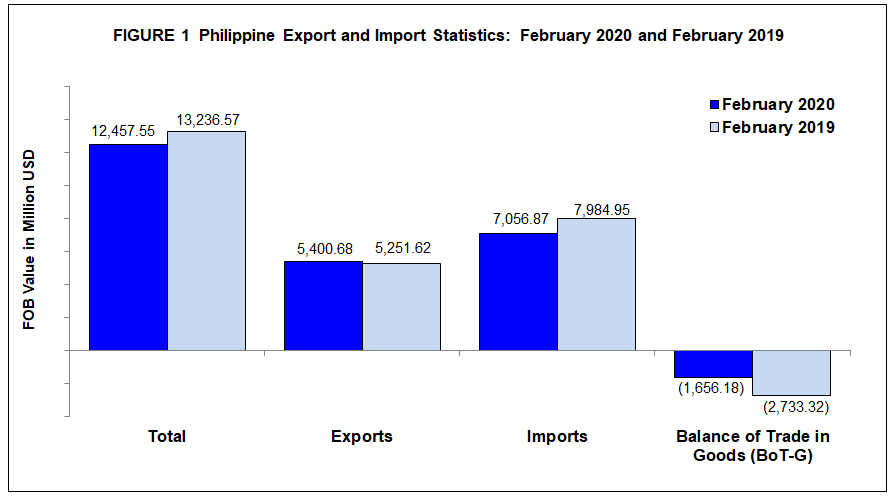
B. EXPORTS
1. Exports increase by 2.8 percent
The country’s total export sales in February 2020 was USD5.40 billion, an increase of 2.8 percent from the USD5.25 billion total export sales in February 2019.
Largely contributing to the uptrend in February 2020 were six of the top 10 major export commodities, namely, other manufactured goods (45.0%); banana (fresh) (29.6%); other mineral products (13.2%); machinery and transport equipment (11.7%); gold (6.0%); and electronic products (3.4%). (Table A.2 and Table 3)
TABLE A.2 Top 10 Philippine Exports to All Trading Partners
February 2020p
Year-on-Year Growth in Percent
| Gainers | Losers | ||
| Major Commodity Group | Annual Growth Rate, % | Major Commodity Group | Annual Growth Rate, % |
| Other Manufactured Goods | 45.0 | Cathodes and Sections of Cathodes, of Refined Copper | -25.4 |
| Bananas (Fresh) | 29.6 | Metal Components | -11.7 |
| Other Mineral Products | 13.2 | Ignition Wiring Set and Other Wiring Sets Used in Vehicles, Aircrafts and Ships | -2.5 |
| Machinery and Transport Equipment | 11.7 | ||
| Gold | 6.0 | ||
| Electronic Products | 3.4 | ||
| p - preliminary | |||
2. Exports of electronic products comprise more than half of the total exports
By commodity group, exports of electronic products continued to be the country’s top export with total earnings of USD2.93 billion. This amount, which accounted for 54.2 percent of the total exports in February 2020, expanded by 3.4 percent, from USD2.83 billion in February 2019. (Figure 2 and Table 3)
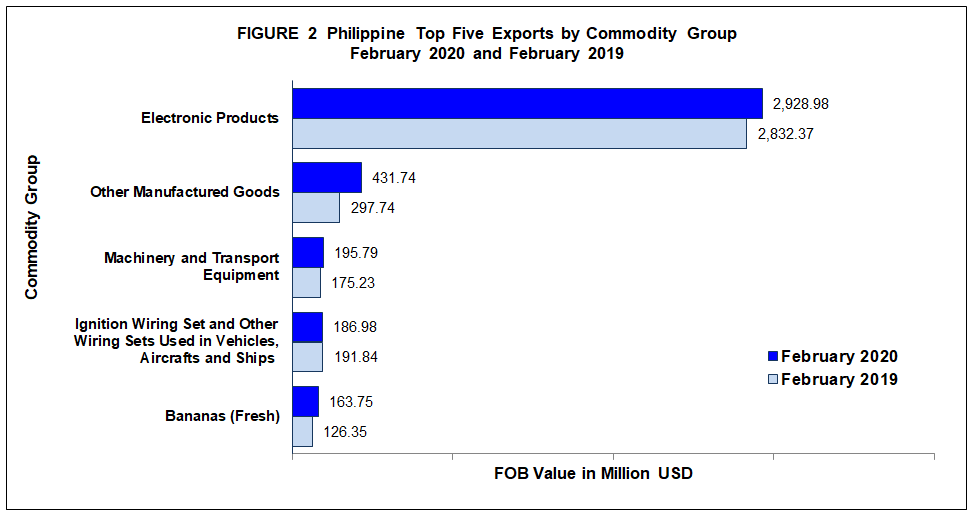
3. Manufactured goods has the highest share to exports among major types of goods
By major type of goods, exports of manufactured goods accounted for the highest share of USD4.39 billion (81.4%) to the total exports in February 2020. This type of goods went up by 1.3 percent, from its level a year ago of USD4.34 billion. (Figure 3 and Table 5)
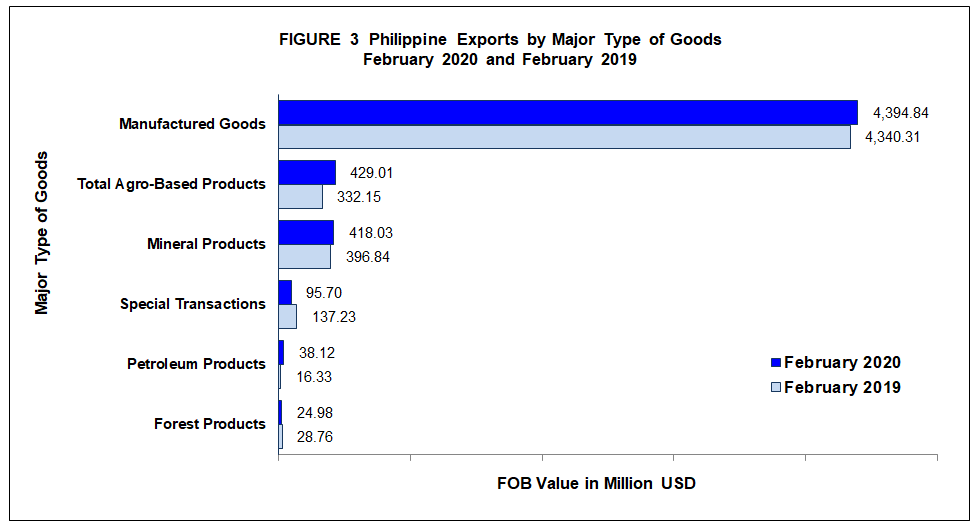
4. Japan contributes the highest export value
By major trading partner, exports to Japan comprised the highest value amounting to USD929.00 million (17.2%) during the month. Exports to this country grew by 11.3 percent, from USD834.77 million in February 2019.
Other major export trading partners were United States of America (USA) with export value of USD871.05 million; Hong Kong, USD662.07 million; People’s Republic of China, USD584.44 million; and Singapore, USD313.01 million. (Figure 4 and Table 7)
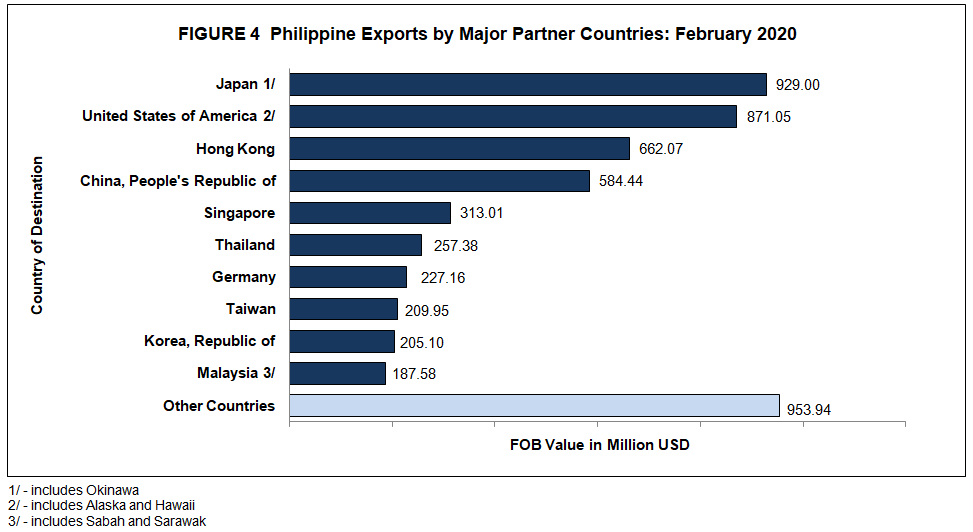
5. Majority of exports are for APEC countries
By economic bloc, USD4.50 billion (83.3%) of the country’s merchandise exports in February 2020 went to APEC member countries. Export value to APEC countries climbed by 2.4 percent, from USD4.40 billion in February 2019. (Figure 5 and Table 8)
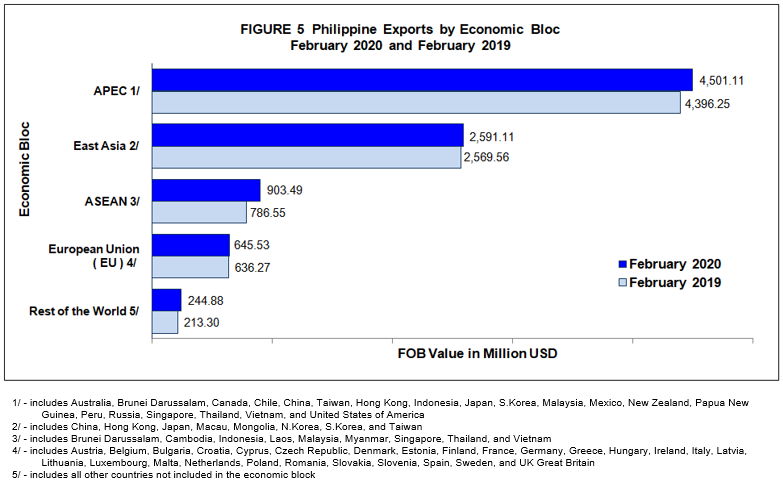
C. IMPORTS
1. Imports decrease by 11.6 percent
Total imported goods in February 2020 amounted to USD7.06 billion, indicating a drop of 11.6 percent, from the imported goods during the same month of the previous year amounting to USD7.98 billion.
The decrement was due to the decreases in the top 10 major import commodities led by cereals and cereal preparations (-28.2%); industrial machinery and equipment (-24.7%); and transport equipment (-17.6%). (Table A.3 and Table 9)
TABLE A.3 Top 10 Philippine Imports from All Trading Partners
February 2020p
Year-on-Year Growth in Percent
| Major Commodity Group | Annual Growth Rate, % |
| Cereals and Cereal Preparations | - 28.2 |
| Industrial Machinery and Equipment | - 24.7 |
| Transport Equipment | - 17.6 |
| Telecommunication Equipment and Electrical Machinery | - 16.9 |
| Mineral Fuels, Lubricants and Related Materials | - 12.0 |
| Other Food and Live Animals | - 9.0 |
| Plastics in Primary and Non-Primary Forms | - 7.5 |
| Iron and Steel | - 4.0 |
| Electronic Products | - 2.4 |
| Miscellaneous Manufactured Articles | - 0.4 |
| p - preliminary | |
2. Electronic products account for the highest import value
Among the imported commodity groups, import of electronic products, valued at about USD2.00 billion, contributed the highest share of 28.3 percent to the total imports. Import of this commodity group, however, declined by 2.4 percent in February 2020, from USD2.05 billion in February 2019. (Figure 6 and Table 9)
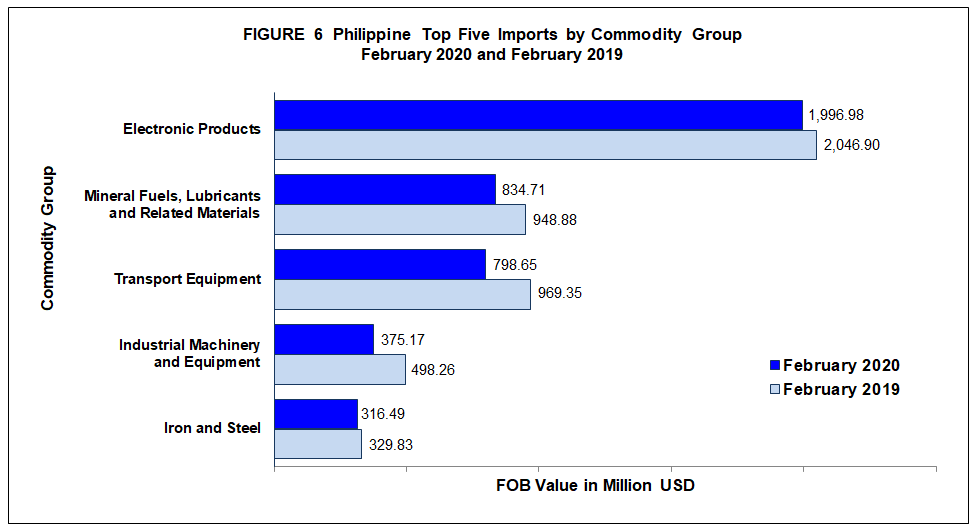
3. Imports of raw materials and intermediate goods contribute the highest
By major type of goods, imports of raw materials and intermediate goods accounted for the largest share of USD2.66 billion (37.7%) in February 2020. This type of goods, however, dropped by 8.7 percent, from USD2.91 billion in February 2019.
Imports of capital goods, which shared 32.7 percent or an import value of USD2.31 billion, ranked second. Consumer goods placed third with a share of 16.9 percent or an import value of USD1.19 billion. (Figure 7 and Table 11)
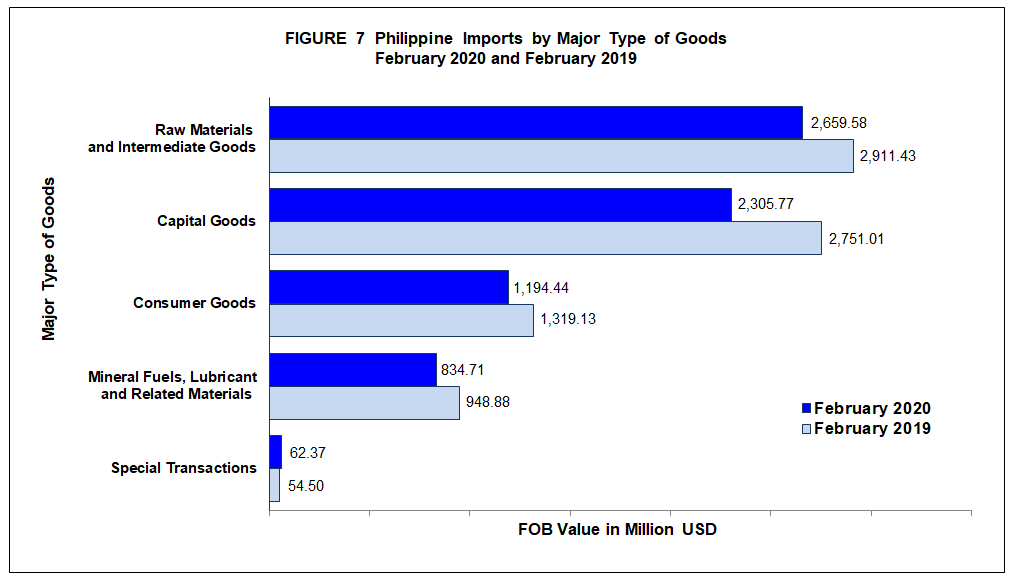
4. People’s Republic of China has the highest import value
The People’s Republic of China was the country’s biggest supplier of imported goods with 12.9 percent share to the total imports in February 2020. Import value from this country amounted to USD908.79 million during the month, from USD1,618.02 million in February 2019.
Other major import trading partners were Japan with import value of USD799.23 million; Republic of Korea, USD627.39 million; USA, USD615.68 million; and Thailand, USD528.25 million. (Figure 8 and Table 13)
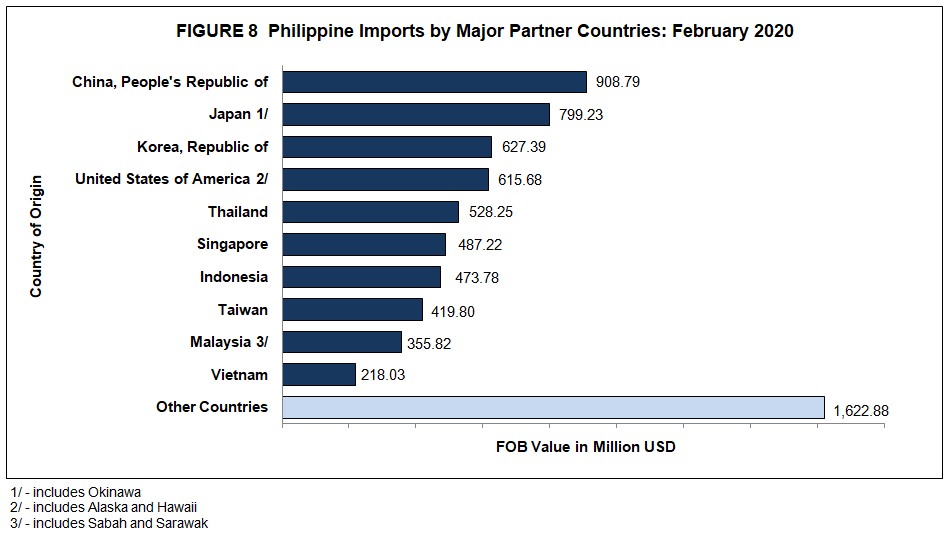
5. Imports come largely from APEC member countries
By economic bloc, Asia-Pacific Economic Cooperation (APEC) was the biggest supplier of the country’s imports in February 2020 with a value of USD5.87 billion (83.2 %). This amount, however, went down by 10.2 percent, from USD6.54 billion in February 2019. (Figure 9 and Table 14)
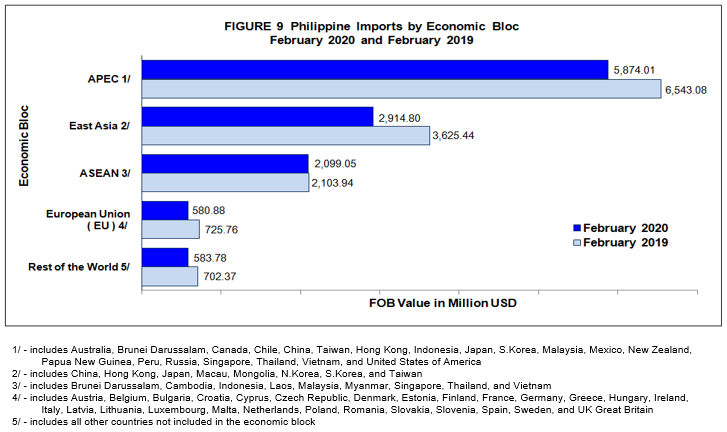
CLAIRE DENNIS S. MAPA, Ph.D.
Undersecretary
National Statistician and Civil Registrar General
Explanatory Notes
Export and import trade statistics are compiled by the Philippine Statistics Authority (PSA) from export and import documents submitted to the Bureau of Customs (BOC) by exporters and importers or their authorized representatives as required by law. The PSA regularly collects the following documents:
1. Export Declaration (ED – DTI form);
2. Import Entry and Internal Revenue Declaration (BOC IEIRD Form 236);
3. Informal Import Declaration and Entry (BOC Form 177); and
4. Single Administrative Documents (SAD)
The digitized copies of all documents are provided by BOC and PEZA to PSA on a monthly basis through email.
The output of the Automated Export Documentation System (AEDS) of the BOC is being utilized to generate export statistics. AEDS is a paperless transaction in lieu of the manual filling up of export documents.
Moreover, an electronic copy of the IEIRD, or SAD, is utilized to capture the monthly import figures. SAD-IEIRD is an on-line submission of import documents either by brokers or companies. These are transactions that pass through the Automated Cargo Operating System (ACOS), now called the e2m (electronic to mobile) customs system, which is implemented through the BOC e-Customs Project.
All documents (hard copies and e-files) received within the cut-off date, which is every 30th day of the month, are compiled, processed, summarized, analyzed and disseminated through monthly statistical tables, and press releases. Processing includes coding, editing, review and validation of results. All documents received after the cut-off date are included in the generation of the revised monthly statistical tables which are available 10 to 15 working days after the press release date.
The press release for a reference month is every 40th day after the reference month. However, if the 40th day falls on a Saturday, the release is made a day earlier (Friday). If it falls on a Sunday or Monday, the release is on Tuesday. Moreover, If the release date falls on a holiday, the date of release is moved accordingly.
The 2015 Philippine Standard Commodity Classification (PSCC) is used to classify the commodities at 10-digit code level for statistical purposes.
Data requests on international merchandise trade statistics can be made at the PSA, Economic Sector Statistics Service, Trade Statistics Division (telephone number: (02) 8376-1975 or at email address, j.soliven@psa.gov.ph).
See more at the Foreign Trade landing page.
